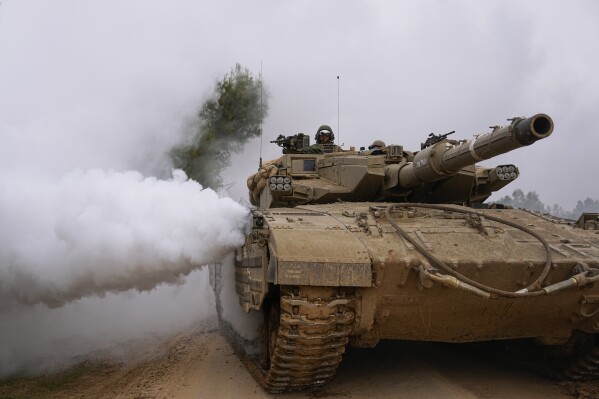Russia's Prized A-50 Spy Plane Loss May Signal 'Preparation' for F-16s
Russia may have been preparing for the imminent arrival of U.S.-made F-16s in Ukraine when it allegedly lost two high-value aircraft far behind the front lines.
On Monday, Ukraine's top soldier, General Valery Zaluzhny, said Kyiv's forces had "destroyed" a Russian A-50 spy plane and an Il-22 air control plane over the Sea of Azov. Kyiv posted an image showing the two aircraft in the style it typically announces Russian losses, saying the planes came down at around 10 p.m. local time on Sunday.
Who did this? 𤫠pic.twitter.com/Zo0JlcQw04
— Ukrainian Air Force (@KpsZSU) January 15, 2024
Pro-Kremlin Russian military bloggers, who are influential voices in Russian military discourse, also posted similar reports about the aircraft. Kremlin spokesperson Dmitry Peskov said on Monday he had "no information about the downing of Russian planes by the Ukrainian armed forces."
The Beriev A-50 is an Airborne Early Warning and Control aircraft, used by Russia to detect Ukrainian air defenses and help coordinate attacks carried out by other Russian aircraft. Each costs hundreds of millions of dollars.
The circumstances around the fate of the aircraft are not clear. Some experts suggested a Ukrainian-operated Patriot air defense system may have been responsible, but Ukraine has not confirmed this.
But there have been "clear indications" in recent weeks that Moscow has used its A-50 alongside Russia's advanced S-400 and S-500 surface-to-air missile systems and long-range missiles, according to Frederik Mertens, an analyst with the Hague Centre for Strategic Studies.
This is a more "aggressive way" of using the Airborne Early Warning aircraft, making for "a very dangerous and deadly combination," Mertens told Newsweek.
"In my opinion, this is a deliberate Russian preparation for the impending arrival of the F-16," he added.
Russian forces are trying to mold the battle in the skies by pushing Ukraine's air force back as far as possible, "while causing as much attrition as they can in the expectation of the arrival of the F-16 fighters," he said.
Moscow may well hope to strike F-16s on the ground and in the air as soon as they can, and the more powerful Russia's forces and ground-based defenses are in that moment, the better for Moscow, argued Mertens.
This is a "reasonable" conclusion to draw, agreed David Jordan of the Freeman Air and Space Institute at King's College, London. But there are likely several reasons behind Russia's actions, including a "desire to be able to track more aircraft deeper into Ukraine" and secure earlier warnings of possible attacks, he told Newsweek.
"It is quite plausible that the Russians are taking risks to improve their chances of hitting an F-16" once the jets arrive, weapons and military expert David Hambling told Newsweek.
Ukraine is expected to receive its first operational F-16s from Western allies in the next few months, giving Kyiv's air force more modern avionics and better radars. With the jets, Ukraine will be able to operate from farther distances, taking out Russian ground-based defenses more easily and keeping Russian jets at bay. Although not a silver bullet, the aircraft are expected to make Russian strikes on Ukraine more difficult to carry out, endanger Russian assets and counter any superiority Russia has in the air.
A-50s are key assets for the fourth-generation aircraft Russia deploys. They are especially important for intercepting low-flying cruise missiles and aircraft or long-range drone strikes, Mertens said.
"Defending its territory from impending Ukrainian cruise missile and drone strikes is already a challenge for Moscow and has only become more difficult," he argued.
Fewer A-50s and other early warning systems would leave Russia's ships in the Black Sea "very vulnerable to surprise attacks" by low-flying F-16 fighters, with Moscow's defenses working around the clock, Mertens said.
"Crucial is their 'look-down' capability: at the height at which they operate, their radar horizon stretches much further than a ground-based radar," Mertens said of A-50s.
Colonel Natalia Humeniuk, a spokesperson for Ukraine's southern forces, described the two aircraft allegedly downed on Sunday as the "eyes" of Russian forces.
"Such a hit will be quite sensitive and will at least delay future missile strikes," she said.
Russia has a "limited inventory" of these aircraft, and "the aircraft they have will be heavily used and we know aircraft maintenance in Russia is under severe strain," Mertens said.
If Ukraine did take out the A-50 on Sunday, this is a "significant" win for Kyiv, the British Defense Ministry said on Wednesday.
"It is likely that Russia will now be forced to reconsider limiting the operational areas of its aircraft," the U.K. government said.
Moscow's air force has eight A-50s, but the "increased stress" on the remaining aircraft and the loss of a crew will affect how effective they can be, London added.
The A-50 "was and is a priority target for us," Colonel Yuriy Ihnat, a spokesperson for Ukraine's air force, said in a post to Facebook on Monday. He also shared an image appearing to show the Il-22, with visible damage to its tail.
Disclaimer: The copyright of this article belongs to the original author. Reposting this article is solely for the purpose of information dissemination and does not constitute any investment advice. If there is any infringement, please contact us immediately. We will make corrections or deletions as necessary. Thank you.




